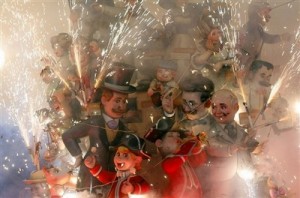Festival in Valencia: Las Fallas
 Definitely considered one of the most wacky and unique festivals in Spain, Las Fallas de Valencia – literally translated to mean ‘the fires’ in Valenciano – is a massive festival in Valencia, celebrated in vigour and awe every March.
Definitely considered one of the most wacky and unique festivals in Spain, Las Fallas de Valencia – literally translated to mean ‘the fires’ in Valenciano – is a massive festival in Valencia, celebrated in vigour and awe every March.
This grand festival is the biggest of its kind in Valencia, and is much anticipated by the Valencianos. If you happen to be in town during the Fallas, don’t be surprised to see huge blazing fires around the city.The festival is focused on creating huge cardboard, wood, papier-mâché and plaster statues that are referred to as “fallas” or “ninots”, and then setting them on fire.
Substantial effort is put into making them look realistic; most of them depict a myriad of daily-life characters and topics such as corrupt politicians and celebrities. Las Fallas is a very labour-intensive festival, with the giant statues taking up to a year to prepare and can cost up to $60,000. A year-round effort is placed into making the festival a success.
 History of Las Fallas
History of Las Fallas
Las Fallas started out as a feast day for Saint Joseph, the patron saint of carpenters. Athought the exact origins are not clearly known, most believe that the fires evolves from the pagan rituals celebrating the arrival of spring and cultivation season. Back in those days (approximately 16th century), streetlights in Valencia were only used in the Spanish winter, when nights were bitter and cold. The wooden structures that used to contain these street lamps were ceremoniously burned on Saint Joseph’s day as the days got longer.
Through the years, it slowly evolved into a five-day, multifaceted celebration involving massive fires. Today, the festival has become much of a celebratory event. The population of Valencia, swells from just over 1 million to an estimated three million during Las Fallas celebrations. Flame-lovers and festival revelers from all around Spain flock to Valencia to be part of the festivities.
When and How Las Fallas are Celebrated
Each year, the celebrations start on the 15th March and ends on 19th March, the day of La Cremá (the burning). Each day of Las Fallas kicks off at 8am with La Despertà (literally meaning the wake-up call): a series of brass bands will march down the city’s main roads playing lively music, followed by the “fallars” as firecrackers are set off in the street as they walk.
 The next event, La Mascletà, features a plethora of firecracker and fireworks in each neighborhood at 2pm. The main Mascletà event takes place in the Plaça de l’Ajuntament and has pyrotechnicians competing for the chance to set off the final Mascletà on March 19th.
The next event, La Mascletà, features a plethora of firecracker and fireworks in each neighborhood at 2pm. The main Mascletà event takes place in the Plaça de l’Ajuntament and has pyrotechnicians competing for the chance to set off the final Mascletà on March 19th.
One of the most magnificent events of the festival is called the Ofrenda de Flores a la Virgen de los Desamparados (an offering of garlands to our Lady of the Forsaken). On the 17th and 18th of March from 4pm to the evening, members of the Fallas parade in their colorful traditional costumes, carrying bundles of flowers as the offering to their Patron Saint.
Through out the festival, the old riverbed in Valencia is home to nightly fireworks displays that get more impressive each night, culminating on the final night called La Nit del Foc (the night of fire). Fortunately March in Spain promises pleasant temperatures and mild weather, so the festival celebrations are rarely affected by the weather.
To get the latest updates or watch live broadcast of Las Fallas events, go to the festival’s official website.
Read more on other festivals in Spain:
>> Festival of San Fermin: Running of the Bulls
>> La Tomatina: Spain’s Biggest Food Fight
>> Batallo del Vino: Spain’s Messiest Wine Battle
>> Wacky and Unique Festivals in Spain
>> Festivals in Seville
Photo credit: Flickr photos by EpicFireworks, Fabio Gava, and Wikipedia.